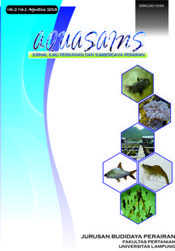STRATEGI PENGATURAN PENANGKAPAN BERBASIS POPULASI DENGAN ALAT TANGKAP BUBU RANGKAI PADA PERIKANAN RAJUNGAN: STUDI KASUS DI PERAIRAN KABUPATEN KONAWE SULAWESI TENGGARA
Abstract
Perikanan rajungan di PerairanKabupaten Konawe, Sulawesi Tenggara
dilingkupi permasalahan kurang efisiennya
alat tangkap yang digunakan (bubu
tunggal dan jaring insang dasar) yang
berdampak pada tekanan terhadap populasi
rajungan. Penggunaan bubu rangkai
diharapkan dapat mengatasi permasalahan
tersebut. Penelitian ini bertujuan untuk
menganalisis ukuran dan kematangan gonad
rajungan hasil tangkapan bubu rangkai
berdasarkan fase bulan serta efisiensi
ekonomis alat tangkap ini. Hasil penelitian
menunjukkan kecenderungan lebar karapaks
dan bobot individu rata-rata yang
lebih tinggi pada fase bulan awal terang
dan fase bulan terang, walaupun rata-rata
jumlah individu yang tertangkap per tirip
lebih tinggi pada fase bulan terang dan
awal gelap. Hanya sedikit rajungan matang
gonad yang tertangkap. Strategi yang dapat
diterapkan untuk meningkatkan sifat
ramah lingkungan bubu rangkai adalah: Bubu
dipasang pada kedalaman >15 meter
untuk memperoleh ukuran yang lebih besar;
Operasi penangkapan dapat difokuskan
pada fase bulan awal terang dan terang
untuk memperoleh bobot individu yang lebih besar; Bila tertangkap rajungan dengan
lebar karapaks < 10cm atau betina matang
gonad dapat dilepas kembali ke alam;
Untuk efisiensi pemasaran, hasil tangkapan
dapat ditampung sementara dalam kurungan
tancap dan diberi pakan ikan rucah.
Usaha penangkapan rajungan dengan
bubu rangkai layak dan menguntungkan secara
ekonomis dengan nilai NPV Rp. 84 .
098 . 870, B/C - ratio 23 dan IRR 605 %.
Downloads
Download data is not yet available.
Downloads
Published
2013-08-12
How to Cite
Mustafa, A., & Abdullah, A. (2013). STRATEGI PENGATURAN PENANGKAPAN BERBASIS POPULASI DENGAN ALAT TANGKAP BUBU RANGKAI PADA PERIKANAN RAJUNGAN: STUDI KASUS DI PERAIRAN KABUPATEN KONAWE SULAWESI TENGGARA. AQUASAINS, 2(1), 45–52. Retrieved from https://jurnal.fp.unila.ac.id/index.php/JPBP/article/view/195
Issue
Section
Articles
License
License for Authors
Authors who publish with this journal agree to the following terms:
- Authors retain copyright and grant the journal right of first publication with the work simultaneously licensed under a Creative Commons Attribution License that allows others to share the work with an acknowledgement of the work's authorship and initial publication in this journal.
- Authors are able to enter into separate, additional contractual arrangements for the non-exclusive distribution of the journal's published version of the work (e.g., post it to an institutional repository or publish it in a book), with an acknowledgement of its initial publication in this journal.
- When the article is accepted for publication, its copyright is transferred to Aquasains Journal. The copyright transfer convers the exclusive right to reproduce and distribute the article, including offprint, translation, photographic reproduction, microfilm, electronic material, (offline or online) or any other reproduction of similar nature.
- Authors are permitted and encouraged to post their work online (e.g., in institutional repositories or on their website) prior to and during the submission process, as it can lead to productive exchanges, as well as earlier and greater citation of published work (See The Effect of Open Access).
- The Author warrant that this article is original and that the author has full power to publish. The author sign for and accepts responsibility for releasing this material on behalf os any and all-author. If the article based on or part os student’s thesis, the student needs to sign as his/her agreement that his/her works is going published.
License for Regular Users
Other regular users who want to cite, distribute, remix, tweak, and build upon author’s works, even for commercial purposes, should acknowledge the work’s authorship and initial publication in this journal, licensed under a Creative Commons Attribution License.
This license lets others distribute, remix, tweak, and build upon your work, even commercially, as long as they credit you for the original creation.
This work is licensed under a Creative Commons Attribution 4.0 International License.Copyright Transfer Statement can be downloaded here


.png)









